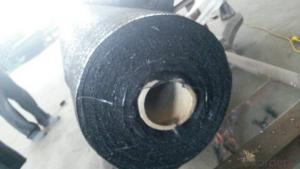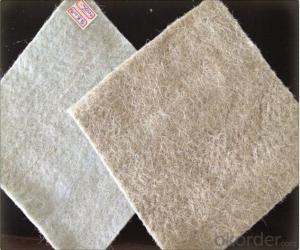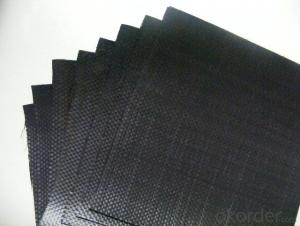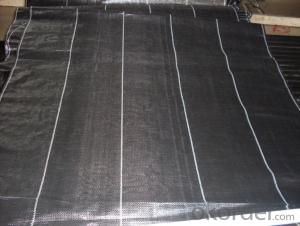Nzta Geotextile Woven Fabric/Landscape Fabric/Groundcover
- Loading Port:
- China main port
- Payment Terms:
- TT OR LC
- Min Order Qty:
- 1000 m²
- Supply Capability:
- 10000 m²/month
OKorder Service Pledge
OKorder Financial Service
You Might Also Like
1. Groundcover Fabric Description:
Groundcover Fabric is made of environmentally friendly raw materials, pp woven fabric. It used to prevent the growth of weed, without the use of potentially dangerous chemical sprays or labor intensive hoeing. Once installed, weed mat will continue providing protection for years without maintenance.

2. Groundcover Fabric Specification:

3. Groundcover Fabric Functions and Features:
1)Excellent weed control
2)Excellent UV resistance
3)Moisture,fertilizers,air reach plants to allow for healthy soil
4)Good water and air permeability
5)Exceptional toughness and strength
6)Durable,tear-resistant,anti-rot and anti-mildew
7)Light weight,easy to install,follows natural ground contours
8)Ideal for use in landscaped beds,under decks and walkways
9)Fashionable design,high quality,competitive price
10)Long service life

4. Groundcover Fabric Property:
1) Light weight, high strength, low elongation, easy to construct.
2) Reinforcement, separation, drainage and filtration, fencing function, etc.
5. Groundcover Fabric Application:
It can be widely used in areas of railways, highways, sport fields, earthwork, etc.

6. FAQ:
Q1:Can you send samples to us ?
A1:Yes , free samples could be provided , but customer need pay for the freight cost . After order placed , the freight charge could be refund .
Q2:What’s your Payment term ?
A2:T/T , L/C , Western Union,Paypal ...
Q3:What’s your manufacture process time ?
A3:Usually within 20 days
- Q: Principle of drainage pipe geotextile
- Principle of drainage pipe geotextile
- Q: What are the applications of geotextiles in civil engineering?
- Geotextiles have a wide range of applications in civil engineering. They are commonly used in road construction, where they provide reinforcement and stabilization to the soil, preventing the formation of cracks and potholes. Geotextiles are also used in the construction of embankments and retaining walls, where they provide erosion control and improve soil stability. Additionally, they are used in drainage systems to filter out fine particles and prevent clogging. Overall, geotextiles play a crucial role in enhancing the performance and durability of various civil engineering structures.
- Q: Any information on geotextiles? I am doing a mock united nation and we are representing turkey and a big issue there is erosion and we were thinking of proposing to use geotextiles and I really need to know defects of using this product, installations for this, prices, if it can be used on a big area, and if it could work for turkey. Any information will help!
- geotextile reinforcement is used to coat the ground in peatlands to make way Maintenance of a good slope stability, one needs to make the soil reinforcement (reinforcement of earth) by using geotextile Benefits of geotextile applications: Improving the design safety factor Increasing the height of the embankment Reducing the displacement embankment during construction Improve performance by increasing uniformity embankment after construction completion geotextile layer was placed on the slope during
- Q: The amount of geotextile drainage of the drainage pipe, as well as the amount of gravel block ye count
- Calculate the surface area of the water pipe, and then add a 10% of the amount, is the amount of geotextile, Huazhi geotextile material manufacturers to answer
- Q: What are the key considerations for geotextile installation in areas prone to landslides?
- The key considerations for geotextile installation in areas prone to landslides include: 1. Site evaluation: Conduct a thorough assessment of the site to understand the slope stability, soil conditions, and potential triggers for landslides. This will help determine the appropriate type and strength of geotextile needed. 2. Design and engineering: Engage geotechnical engineers to design a tailored solution based on the specific needs of the site. They will consider factors such as slope gradient, soil type, and expected loads to determine the appropriate geotextile specifications. 3. Drainage management: Proper drainage is critical to prevent water accumulation, which can increase the risk of landslides. Geotextiles can be used to enhance drainage by allowing water to pass through while retaining soil particles. 4. Anchoring and securing: Geotextiles should be securely anchored to the slope to ensure stability. This may involve using appropriate anchor systems or integrating the geotextile into the existing slope or retaining structure. 5. Monitoring and maintenance: Regular monitoring is essential to identify any signs of distress or movement in the slope. Timely maintenance and repair of the geotextile system can help prevent potential failures and ensure its long-term effectiveness in landslide-prone areas.
- Q: How are geotextiles used in drainage systems?
- Geotextiles are commonly used in drainage systems to enhance their efficiency and longevity. These synthetic fabrics are placed in various parts of the system, such as around pipes or in trenches, to act as a filter and separator. By preventing the clogging of soil particles, geotextiles allow water to flow through while preventing the passage of fine particles. This helps maintain the system's hydraulic capacity and prevents blockages, ultimately improving the overall performance of the drainage system.
- Q: Can geotextiles be used in dam construction?
- Yes, geotextiles can be used in dam construction. Geotextiles are commonly used as a part of the filter and drainage system in dam construction projects to enhance stability, prevent soil erosion, and improve overall performance of the structure. They can help manage water flow, reinforce the soil, and provide long-term protection against erosion and piping.
- Q: How do geotextiles help in reducing the risk of slope failures?
- Geotextiles help in reducing the risk of slope failures by providing reinforcement and stability to the soil. They are used to reinforce weak soils, improve their shear strength, and prevent erosion. By acting as a barrier, geotextiles help to distribute the load and reduce the stress on the slope, minimizing the chances of failure. Additionally, they also allow for proper drainage, reducing water pressure and preventing saturation of the soil, which is a common cause of slope failures. Overall, geotextiles play a crucial role in enhancing the stability and safety of slopes.
- Q: Can geotextiles be used in retaining wall construction?
- Yes, geotextiles can be used in retaining wall construction. They are often used as a reinforcement material to improve the stability and longevity of the wall. Geotextiles can help in preventing soil erosion, providing drainage, and increasing the overall strength of the retaining wall.
- Q: 250 grams of geotextile how much money a square
- Geotextile price is calculated by the index and thickness of the general GB 250g geotextile price of the market price of 2.5 yuan, the most accurate formula please consult Hongxiang Meng Xiangyu.
Send your message to us
Nzta Geotextile Woven Fabric/Landscape Fabric/Groundcover
- Loading Port:
- China main port
- Payment Terms:
- TT OR LC
- Min Order Qty:
- 1000 m²
- Supply Capability:
- 10000 m²/month
OKorder Service Pledge
OKorder Financial Service
Similar products
Hot products
Hot Searches
Related keywords


































